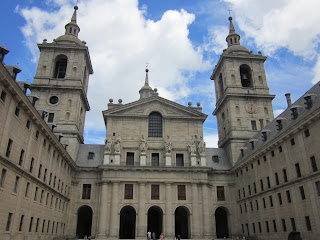Today we travel to two small towns about an hour from
Madrid. Each of these towns could be a one or two day trip from the capital
city, but we cram them both into a full day… just a taste to make us wanting
more.
As we drive into Segovia the 2000-year-old Roman aqueduct appears
as a small knee wall that grows to become full size, 2500 feet long by 100 feet
high. It has 118 arches and is
made from 20,000 pieces of granite.
Held together without the use of concrete or mortar, it functioned up
until the middle of the 19th century and would be in use today if it was not
for the fear of the masses being so easily poisoned as the water makes its
route in the open crevasse. More
secure plumbing is used today to bring water to the masses.
Upon arrival, several hundred or more runners queuing up to
a 5K and 10K race meet us. Blaring
music and a loud sports commentator fills the small village, as the race is
about to begin. Meandering through tiny streets and alleyways, we paused along
the way as our guide pointed out various buildings of interest, a mixture of
Moorish and Renaissance design.
Onto Alcazar, a Moorish palace, home to monarchs of the Castile region. The Alcazar is the aqueducts final destination as it provided water to the fortress. The building itself burned in 1862 and has since served as a museum rather than a residence.
A 45-minute drive to El Escorial dropped us at the massive Monasterio de San Lorenzo de El Escorial. Built in the mid to late 1500s as a fortress of power and seasonal home for the monarch, it serves as a mausoleum for the kings and queens, complete with a community of monks that pray for their souls on a daily basis.
When I heard we were going to a monastery, my only reference
was a quaint one off Tenby in Wales where robe dressed monks sold chocolate and
perfume to tourists. Imagine my
surprise when this massive structure that looks more like a prison looms in the
distance.
Catholic King Phillip II ruled the Inquisition from this
massive gloomy fortress as sort of a medieval Camp David. Today is houses the few bony remains of
past kings, and queens in the Royal Pantheon. These elaborate marble caskets
are filed from floor to ceiling arranged with kings on one side and their last
wives on the other. There are only
a few spaces left in the current arrangement so there may be some eviction of
formers after the last king and his newly crowned son find eventually their way
into this room. This was a truly
amazing room.
In the many rooms called the Pantheon of Royal Children, we
find the lesser royals as well as children who died under the age of seven in
white marble structures.
Each with the name of the deceased in Latin and all are bearing
elaborate designs that resemble wedding cakes.
Unfortunately, no photographs could be taken inside this
massive fortress. We only toured a
small portion of the structure because the majority of the space is the living
quarters of the community of monks.
But, what we did see, was a complete and enjoyable surprise!










No comments:
Post a Comment